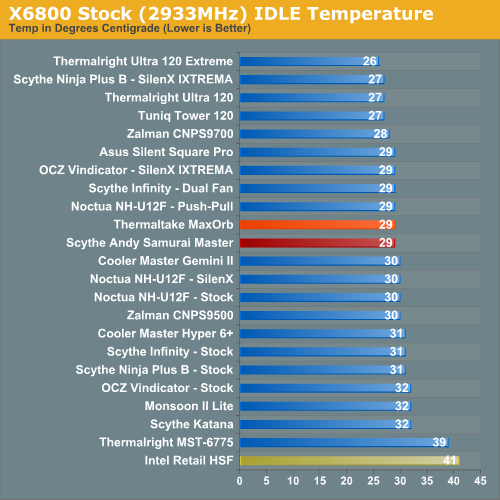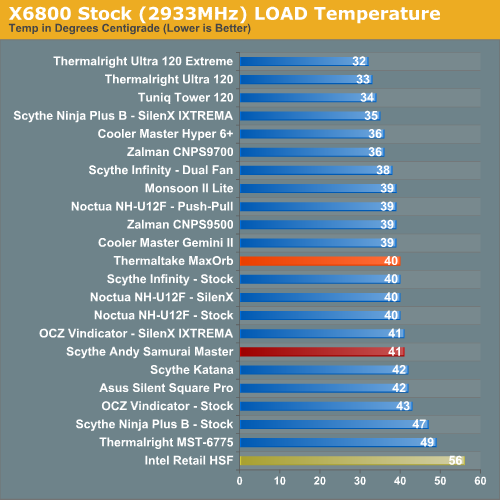Scythe Andy Samurai Master vs. Thermaltake MaxOrb
by Wesley Fink on June 4, 2007 5:00 AM EST- Posted in
- Cases/Cooling/PSUs
Cooling at Stock Speed
Some users will never overclock their CPU, but they still want to run the coolest CPU temperatures possible to enhance stability and extend CPU life. Both the Thermaltake MaxOrb and the Scythe Andy Samurai Master come complete with fans. Therefore we tested both coolers with the supplied fans.

Where the very good Intel stock cooler keeps the X6800 at 41C at idle, the MaxOrb and Andy Samurai both manage 29C, which is a very good performance. This is a significant improvement over the Intel stock cooler, but it is not the best we have tested. The Thermalright coolers, at the top of our heatpipe tower performance charts, cool to 26C and 27C, and the Tuniq 120 maintains 27C. The MaxOrb and Andy Samurai are not the best stock idle coolers we have tested, but they are competitive at the top of stock cooling.
It is more difficult to effectively simulate a computer being stressed by all of the conditions it might be exposed to in different operating environments. For most home users CPU power is most taxed with contemporary gaming. Therefore our stress test simulates running a demanding contemporary game. The Far Cry River demo is looped for 30 minutes and the CPU temperature is captured at 4 second intervals with the NVIDIA monitor "logging" option. The highest temperature during the load test is then reported. Momentary spikes are ignored, as we report a sustained high-level temp that you would expect to find in this recording configuration.
Cooling efficiency of the Scythe Andy Samurai Master and the Thermaltake MaxOrb were compared under load conditions at stock speed to the retail HSF and other recently tested CPU coolers.

The MaxOrb under load at stock speeds reached a maximum temperature of 40C with the embedded fan at high speed. Performance of the Andy Samurai was similar at 41C load temperature at stock speed. This performance compares to the Thermalright coolers at 32C and 33C, the Tuniq at 34C and the Cooler Master Hyper 6+ and Zalman 9700 at 36C. Stock load performance is average at best among tested coolers.
Some users will never overclock their CPU, but they still want to run the coolest CPU temperatures possible to enhance stability and extend CPU life. Both the Thermaltake MaxOrb and the Scythe Andy Samurai Master come complete with fans. Therefore we tested both coolers with the supplied fans.

Where the very good Intel stock cooler keeps the X6800 at 41C at idle, the MaxOrb and Andy Samurai both manage 29C, which is a very good performance. This is a significant improvement over the Intel stock cooler, but it is not the best we have tested. The Thermalright coolers, at the top of our heatpipe tower performance charts, cool to 26C and 27C, and the Tuniq 120 maintains 27C. The MaxOrb and Andy Samurai are not the best stock idle coolers we have tested, but they are competitive at the top of stock cooling.
It is more difficult to effectively simulate a computer being stressed by all of the conditions it might be exposed to in different operating environments. For most home users CPU power is most taxed with contemporary gaming. Therefore our stress test simulates running a demanding contemporary game. The Far Cry River demo is looped for 30 minutes and the CPU temperature is captured at 4 second intervals with the NVIDIA monitor "logging" option. The highest temperature during the load test is then reported. Momentary spikes are ignored, as we report a sustained high-level temp that you would expect to find in this recording configuration.
Cooling efficiency of the Scythe Andy Samurai Master and the Thermaltake MaxOrb were compared under load conditions at stock speed to the retail HSF and other recently tested CPU coolers.

The MaxOrb under load at stock speeds reached a maximum temperature of 40C with the embedded fan at high speed. Performance of the Andy Samurai was similar at 41C load temperature at stock speed. This performance compares to the Thermalright coolers at 32C and 33C, the Tuniq at 34C and the Cooler Master Hyper 6+ and Zalman 9700 at 36C. Stock load performance is average at best among tested coolers.










50 Comments
View All Comments
Tuvoc - Monday, June 4, 2007 - link
I'd love to see you guys test this. It is incredibly cheap, yet many claim it to have class-leading performance. Only a proper Anandtech test can reveal the truth... :-)Imnotrichey - Monday, June 4, 2007 - link
I was thinking the same thing. So many sites swear by the Freezer 7 Pro.yacoub - Monday, June 4, 2007 - link
Why does it look like the heatsink is off-center from the base?http://images.anandtech.com/reviews/cooling/2007/s...">http://images.anandtech.com/reviews/coo...ndy-ther...
Is that poor quality manufacturing or by design? I'd be worried about it not evenly drawing the heat away from the CPU core, leaving a hot spot where the heatsink isn't directly over the contact area.
Also curious: Will you guys ever include the numbers for the Arctic Cooling Freezer 7 Pro? It's sort of a mainstay HSF for socket 775 boards and I'm curious how it compares to the hsfs you have tested. It would be nice to know if it'd be worth ~$50-60 to upgrade from my Freezer 7 Pro or if it is already relatively effective compared to the rest of the field.
oldhoss - Monday, June 4, 2007 - link
This one's kinda recent:
http://www.pureoverclock.com/article642-2.html">http://www.pureoverclock.com/article642-2.html
insurgent - Monday, June 4, 2007 - link
How come nobody reviews the Thermalright SI-128 (sites that matter anyways)? I'd like to know how it compares to the other "high-end" heatsinks.Ver Greeneyes - Monday, June 4, 2007 - link
I have a Thermalright XP-90C installed in my PC, and recently I got the novel idea of turning the cooler upside down so that it's pulling air away from my mobo.. and got a significantly lower temperature. Logically, I don't think down-blowing fans mounted on top of a heatsink make sense - the heat from CPU and surrounding components goes into the heatsink, and then you blow it back down at your mobo? I've also found this setup to be very dusty. My XP-90C might just be an anomaly, but I do wonder how other setups will fare with a fan that faces away from the motherboard.PS: another small advantage is that you can't get at the fan-blades on accident with this setup, although they had better not be pressed against the heatsink itself!
xsilver - Monday, June 4, 2007 - link
p1"However, the MaxOrb is still large enough to mount an integral 110mm fan. As yo"
should be internal?
sjholmesbrown - Monday, June 4, 2007 - link
No, integral is the word. Internal would imply the fan was completely enclosed by the cooler (a'la Tuniq tower), integral means the fan is integrated (catch the link) into the cooler, not a separate component.xsilver - Monday, June 4, 2007 - link
in·te·gral(nt-grl, n-tgrl)
adj.
1. Essential or necessary for completeness; constituent: The kitchen is an integral part of a house.
im no english teacher, but I think im right.
integral means essential - of course a fan is essential to a HSF but the meaning in the sentence was to imply that the fan is internal and cannot be removed.
yacoub - Monday, June 4, 2007 - link
Integral is more correct. It's necessary for proper functioning of the device but it's not internal - that would be something completely inside the heatsink.